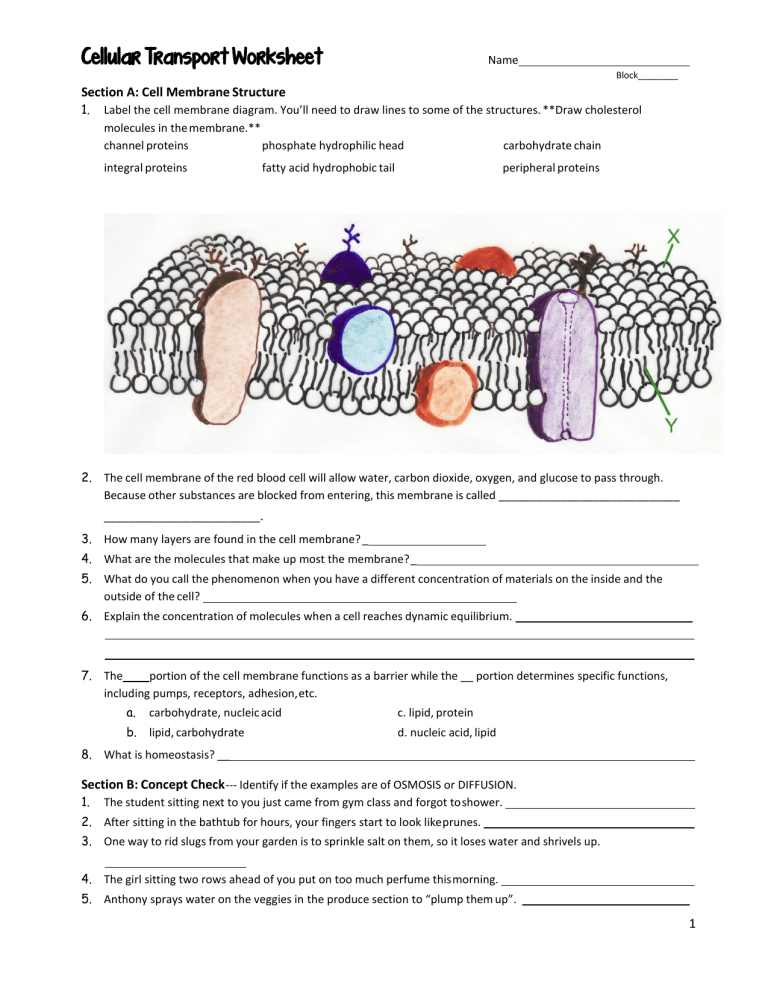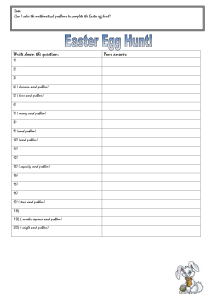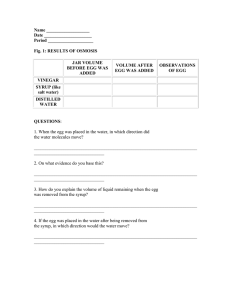
Cellular Transport Worksheet Name Block________ Section A: Cell Membrane Structure 1. Label the cell membrane diagram. You’ll need to draw lines to some of the structures. **Draw cholesterol molecules in the membrane.** channel proteins phosphate hydrophilic head carbohydrate chain integral proteins fatty acid hydrophobic tail peripheral proteins 2. The cell membrane of the red blood cell will allow water, carbon dioxide, oxygen, and glucose to pass through. Because other substances are blocked from entering, this membrane is called _____________________________ _________________________. 3. How many layers are found in the cell membrane? _ 4. What are the molecules that make up most the membrane? _ 5. What do you call the phenomenon when you have a different concentration of materials on the inside and the outside of the cell? 6. Explain the concentration of molecules when a cell reaches dynamic equilibrium. 7. The portion of the cell membrane functions as a barrier while the __ portion determines specific functions, including pumps, receptors, adhesion, etc. a. carbohydrate, nucleic acid b. lipid, carbohydrate c. lipid, protein d. nucleic acid, lipid 8. What is homeostasis? __ Section B: Concept Check --- Identify if the examples are of OSMOSIS or DIFFUSION. 1. The student sitting next to you just came from gym class and forgot to shower. 2. After sitting in the bathtub for hours, your fingers start to look like prunes. 3. One way to rid slugs from your garden is to sprinkle salt on them, so it loses water and shrivels up. 4. The girl sitting two rows ahead of you put on too much perfume this morning. 5. Anthony sprays water on the veggies in the produce section to “plump them up”. 1 Section C: Graphic Organizer -- Fill in the missing information. Active Transport Passive Transport NO Needs to concentration to concentration the concentration gradient the concentration gradient 3 types: 3 types: 1. 1. 2. 2. 3. 3. Section D: Active and Passive Transport 1. Which of the following is true about passive transport? a. It does not allow materials to diffuse. b. It requires energy to create a higher concentration of materials outside the cell. c. It requires energy to create a higher concentration of materials inside the cell. d. It allows particles to pass without the use of cellular energy (ATP). 2. The sodium-potassium pump is a good example of ions being moved out of a cell against a concentration gradient. The concentration of sodium ions is greater on the outside of the cell. What method is used by the cell to rid itself of more sodium? a. osmosis c. facilitated diffusion b. diffusion d. active transport 3. Where are carrier proteins located? 4. Which type of transport is occurring in the diagram? 5. In what type of passive transport do protein channels assist molecules across the membrane? 6. Between an area of high concentration and one of low concentration there is a . 2 7. How does the steepness of the concentration gradient influence the rate of transport? 8. The movement of water across a membrane from high to low water concentration is _____________ . Section D: Egg Demo Day 1 – Get two eggs out of the vinegar bath. Find the mass of each. Place one egg in corn syrup and one egg in distilled water. Predict what you think will happen to the egg soaking in corn syrup overnight. Predict what you think will happen to the egg soaking in distilled water overnight. Day 2 – Mass each egg. EGGS Egg 1 – in corn syrup Day 1 – Mass Day 2 – Mass Appearance of egg on Day 2 Egg 2 – in distilled water Post-lab Questions: 1. Corn syrup egg – Why did the mass change? _ What type of solution is the corn syrup? 2. Distilled water egg – Why did the mass change? __ _ What type of solution is the distilled water? 3. What would happen if we placed the egg in an isotonic solution? 4. What type of transport is illustrated in this demo? require energy? Does this transport Section E: Tonicity STATEMENT ISOTONIC solution HYPERTONIC solution HYPOTONIC solution 1. The concentration of the solute in the solution is lower than the concentration inside the cell. 2. When a cell is placed in this solution, water will enter the cell. 3. Type of solution that animal cells prefer. 4. A plant cell with good turgor pressure. Preferred solution. 5. When this solution is injected into the body, no cell disruption occurs because no net osmosis occurs. 6. The concentration of the solute in the solution is higher than the concentration inside the cell. 7. The concentration of the solute in the solution is the same as in the cell. 8. Plant cells go limp when put in this solution. 9. When a cell is placed in this solution, water will leave the cell. 3 Section F: Concept Check 1. A salt water protozoan is transferred to a freshwater lake. What might happen to the protozoan? 2. Students are observing healthy red blood cells using a microscope. A saltwater solution is added to the red blood cells. Describe the change of the appearance of the RBC after the salt water is added. Identify the type of solution. 3. How would the appearance of the healthy red blood cell change if placed in a solution of pure water? Explain your answer. 4. Which way will the water move? Identify each type of solution. a. b. c. A _ B C 5. In the figure of the U-tube, side “A” is pure water and side “B” is a 10% starch solution. Why is the level of side “B” rising? 6. Which side is HYPERTONIC compared to the other? 4




